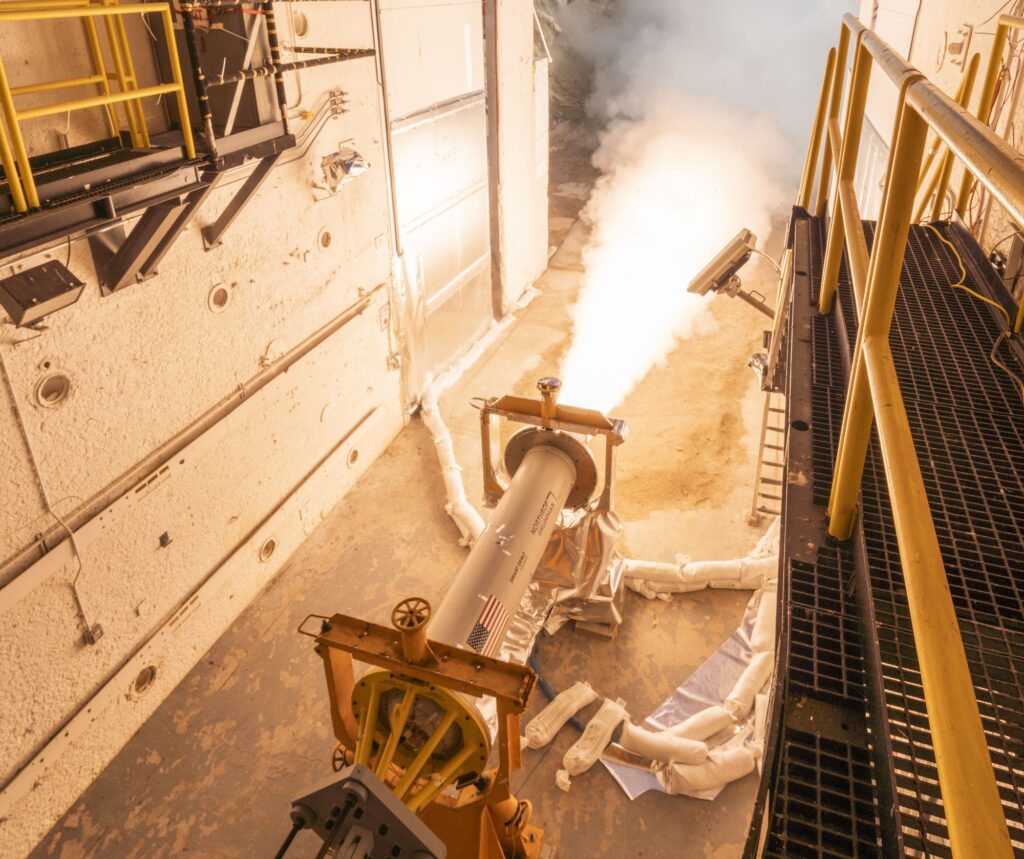Now Reading: Countering China’s Space Silk Road: a U.S. partnership model for the Middle East
-
01
Countering China’s Space Silk Road: a U.S. partnership model for the Middle East
Countering China’s Space Silk Road: a U.S. partnership model for the Middle East


The Middle East is no longer asking whether it should develop domestic space capabilities; it’s deciding with whom it will develop them. If the United States wants to be the country of choice ahead of China, it must create a joint space partnership agreement framework to align American and partner nations’ industry, government and financial goals. The Trump administration has played a decisive role in regional conflicts and has shown a preference for commercial deals over military intervention, which in the past has plagued American foreign policy in the region. In these conditions, the stage is set for the U.S. to define a new era of strategic stability in the Middle East.
The U.S. should take advantage of this window of opportunity to build on the model it established through its partnership with the UAE and lead a broader, structured cooperation framework that helps Middle Eastern states develop domestic space programs aligned with U.S. standards and strategic interests.
As the tumultuous times subside, countries will be looking for ways to expand their economies, and several nations may turn their interests to space. Indeed, some have already started. In recent years, the Middle East has sent a clear signal to the world that it wishes to develop sovereign space programs. Whether the reasoning is based on national security, international prestige or commercial development, how the region develops these programs will have substantial implications for U.S. national security. Since the Middle East and North Africa (MENA) states lack the skilled workforce, infrastructure and expertise needed to develop space programs on par with world leaders, the region will need to look outward for international collaboration and investment. If the U.S. does not fill this demand, adversarial states will.
China has been forming partnerships in the Middle East since 2013, when China and Algeria signed an agreement on cooperation in space science and technology. In 2014, shortly following the advent of the Belt and Road Initiative (BRI), the idea of a Space Silk Road was introduced, expanding the BRI network to space through collaboration on satellite, space launch vehicle, and space infrastructure development. In the years following the announcement, China has developed space and satellite technology with Algeria, Egypt, Saudi Arabia, Sudan and the UAE. The September BeiDou Cooperation Forum highlighted the Middle East as a key region for further proliferation of China’s BeiDou navigation system. The most recent Beidou conference was one of five China has had with the Arab League since 2017.
Currently, the U.S. maintains its technological dominance in space; however, the Chinese aerospace industrial base has seen a surge of progress in recent years due to the military, commercial industry, private investment and policymakers lining up under one strategic objective: to make China the world’s leading space power. With a pace unseen since the race to the moon, this plan is working. Results of China’s global space surge are already visible across the Middle East. As of 2023, all 22 Arab states and the League of Arab States have signed cooperation deals with BRI, which include space programming.
In 2020, the Artemis Accords, led by the U.S., established responsible behavior and governance for space exploration and use. The continuation of Chinese space programming and financing in the Middle East presents a serious threat to the norms laid out by the Artemis Accords. The U.S. must take action to offer the Middle East an alternative to the Chinese model. If we do not, the consequences will be detrimental to U.S. global influence and the freedom of action in space on which modern security depends.
The Middle East is one of the most dynamic regions in the world for space cooperation and offers a chance for the U.S. to form strategic partnerships, bolster its own space power and ensure future allies in the domain. In modeling what these partnerships would look like, there is no better example than the U.S.-UAE relationship. U.S.-UAE space collaboration benefits from the UAE’s status as one of the founding members of the Artemis Accords. Since then, the UAE and the U.S. have reaped the scientific, financial and diplomatic benefits. In 2024, NASA announced the UAE’s Mohammed Bin Rashid Space Centre would provide the lunar Gateway’s crew and science airlock modules for the planned Artemis mission. The UAE has also hosted U.S. space business leaders to engage top Emirati businessmen about the future of space collaboration and the economy. As part of the space partnership, the University of Colorado Boulder collaborated with the UAE to build its Hope spacecraft, which currently monitors Mars’s atmosphere and shares data with the U.S. and the UAE. The partnership has proven to produce tangible benefits for the U.S. and has bolstered the U.S. presence in the region.
If the U.S. wishes to maintain its superiority in space and strategic ties with MENA, it must replicate the U.S.-UAE relationship across the Middle East. Collaborating with MENA allows the U.S. to maintain strong alliances with states that will soon develop their own domestic space programs and shape the norms and practices these agencies use when operating in space. U.S. leadership should work closely with industry, government, and investment firms to tailor a development strategy that is based on a state’s motivation for pursuing a space program.
With this in mind, the U.S. must create a joint space partnership agreement framework to counter Chinese space ambitions and maintain U.S. hegemony. A repeatable agreement that aligns the U.S. and the partner state’s industry, government and finance sectors behind tailored space development strategies that reflect each state’s unique ambitions.
The agreement would be structured as a bilateral memorandum of understanding (MoU) between participating agencies of both states. The U.S. agencies would include the U.S. International Development Finance Corporation (DFC), the Export-Import Bank of the U.S. (EXIM), the Department of State and the Department of Commerce. Agencies from the partner state would include their space agency (if one doesn’t exist, the department under which the new space agency will be created) and sovereign wealth fund (SWF) or state-owned investment firm. The MoU would include three annexes.
- Technical assistance: civil research, university training and data-sharing
- Infrastructure: Assembly, integration and testing (AIT) clean room, ground station network, data-centres and supply chain.
- Financing structure: DFC debt financing, EXIM export credit, partner SWF investment and private venture capital.
To be clear, the agreement should not be a blank check. Initial funding could be contingent on verified milestones such as facility commissioning, data-service contracts or initial satellite launch. Furthermore, any payments made to U.S. suppliers would require license checks and U.S. nexus compliance, ensuring partner country programs adopt U.S. standards in cyber-hardening via open-sec testing, end-use monitoring and export controls. These standards will prevent unmanaged dual-use systems when applied to the partner country.
The MoU should also introduce safeguards ensuring sensitive data, material or systems are not proliferated beyond the signatory state. MTCR controls will limit U.S. assistance to launch integration, telemetry and tracking mechanisms, ground data systems, mission operations and safety systems and exclude propulsion, payload design or related manufacturing equipment. Furthermore, any training or joint research under the JSPA will be limited to basic research or anything that can be done under the public domain to remain compliant with U.S. ITAR/EAR restrictions.
To ensure funding and support lead to tangible results under good governance, a joint steering committee (JSC) should be established, including U.S. and partner state auditors. The JSC will meet quarterly to ensure programs are moving forward and publish unclassified reports to promote transparency. Additionally, a technical coordination office will be established in the country to act as a day-to-day oversight and a central contracting authority. Finally, a legal & ethics panel of U.S. state and commerce officials will ensure compliance with export restrictions and larger U.S. national security objectives.
A joint space partnership agreement framework is a repeatable template that can shift U.S. space cooperation in the Middle East from one-off deals and memoranda to a scalable diplomacy tool that strengthens U.S./Middle East relations and bolsters the U.S. space industry. The agreement gives U.S. defense primes and emerging space firms a predictable pipeline of projects such as assembly plants, ground-station networks, and data services. Diplomatic relations between the U.S. and the partner state will improve significantly, isolating adversary states who might try to undercut the effort. Financially, a partnership agreement will allow a partner state to acquire sovereign space capabilities without taking on all risk or debt by sharing it with the U.S. This allows the program to avoid being marked as debt-trap diplomacy, a strategy of using excessive loans to gain strategic influence in a borrowing state.
Should the U.S. fail to act, it will cede the region’s emerging space infrastructure and the norms governing it to Beijing, altering the trajectory of free and fair space use.
Mathew Montiel is graduate student at American University, studying foreign policy and national security with a focus on space and nonproliferation policy. He is a researcher at the American Foreign Policy Council and a research intern at the Emerging Technologies Institute.
SpaceNews is committed to publishing our community’s diverse perspectives. Whether you’re an academic, executive, engineer or even just a concerned citizen of the cosmos, send your arguments and viewpoints to opinion@spacenews.com to be considered for publication online or in our next magazine. The perspectives shared in these opinion articles are solely those of the authors.
Stay Informed With the Latest & Most Important News
Previous Post
Next Post
-
 012024 in Review: Highlights from NASA in Silicon Valley
012024 in Review: Highlights from NASA in Silicon Valley -
 02Panasonic Leica Summilux DG 15mm f/1.7 ASPH review
02Panasonic Leica Summilux DG 15mm f/1.7 ASPH review -
 03How New NASA, India Earth Satellite NISAR Will See Earth
03How New NASA, India Earth Satellite NISAR Will See Earth -
 04And Thus Begins A New Year For Life On Earth
04And Thus Begins A New Year For Life On Earth -
 05Astronomy Activation Ambassadors: A New Era
05Astronomy Activation Ambassadors: A New Era -
06SpaceX launch surge helps set new global launch record in 2024
-
 07From Polymerization-Enabled Folding and Assembly to Chemical Evolution: Key Processes for Emergence of Functional Polymers in the Origin of Life
07From Polymerization-Enabled Folding and Assembly to Chemical Evolution: Key Processes for Emergence of Functional Polymers in the Origin of Life




















